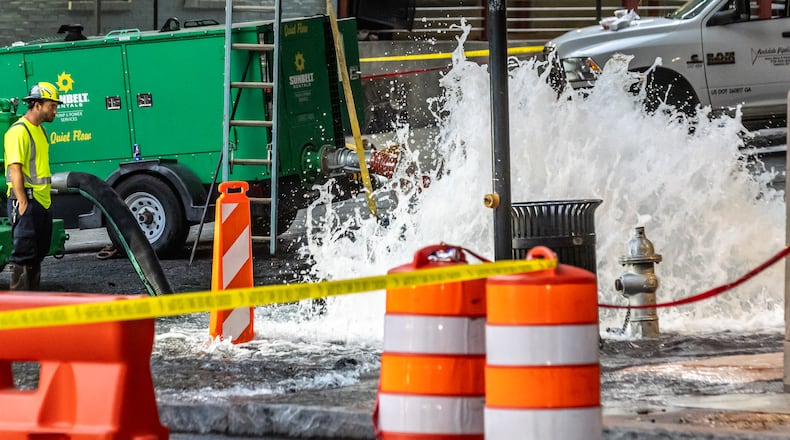As water outages unfolded across metro Atlanta last weekend, the problems for crews working to make repairs extended beyond just how quickly they could do the work.
Could they get the right equipment to finish the job, at all?
City officials had to turn their sights out of state to find equipment and materials to plug the major breaks in Atlanta’s aged water system. Those issues added hours on to an already time-sensitive crisis.
At the site of the break at 11th and West Peachtree in Midtown — where a fountain of water ejected from the roadway — crews realized the crucial valve needed to stop the flow was directly under the geyser itself.
Department of Watershed Commissioner Al Wiggins said this week that the device needed to manually stop the flow couldn’t be sourced in Georgia. It’s a specialized piece of equipment resembling a short piece of pipe with a valve.
“It was important for us to use that device because otherwise we would have had to expand the network of customers that would have experienced a disconnection in services,” he said.
But the closest piece of that equipment was in Alabama, hundreds of miles away from where Atlanta officials were scrambling to mitigate a series of breaks that left residents and businesses without drinking water for days on end.
Credit: John Spink/AJC
Credit: John Spink/AJC
Atlanta Police Chief Darin Schierbaum told The Atlanta Journal-Constitution that law enforcement got ahold of the truck driver carrying the vital piece of the puzzle and rushed to meet him on his journey as he hit the state line.
“So at one point, drivers saw Georgia State Patrol rushing alongside a truck with a blue piece of pipe toward the city,” he said.
Responding agencies maneuvered, with lights flashing, around traffic to get the part to the city as soon as possible.
“That is just one example of the work that is being done around the clock by many different facets of city government and our state partners to quickly mitigate this emergency,” Schierbaum said.
Watch: Aerial view of Atlanta water main work
The difficulties in sourcing the right pieces to respond to Atlanta’s emergency crisis isn’t surprising. The city’s water system dates back to 1875 and nearly 450 miles of pipes are 75 years old, according to the watershed department.
Frequently, Atlanta is jockeying with other localities for many of the same parts.
Maria Houser, who oversees water and sewer systems in DeKalb County, told commissioners last month that supply chain issues often require temporary patches while the county waits on materials.
For instance, the county considers an ongoing situation affecting pipes near Peachtree Industrial Boulevard to be an emergency, Houser said. Even still, it’s taking six months to get the materials necessary for a permanent fix.
Larger pipes, like those that broke in Atlanta, are particularly difficult to source, she said.
“We’re in competition with a lot of other people to get materials,” Houser said.
She said supply chain problems have increased since the federal $1 trillion infrastructure bill passed in 2022. Localities once strapped for cash are now flush with money for long-delayed projects.
“As you can imagine, it’s taking time for everybody, from the manufacturers to the suppliers of raw material, to start ramping up to start addressing just a nationwide problem,” she said.
Credit: Miguel Martinez
Credit: Miguel Martinez
During an early Wednesday morning press conference, Atlanta Mayor Andre Dickens celebrated final repairs being made in Midtown and the restoration of water services to all residents. But at the same time, he warned that the crisis was a “call to action” to figure out how major metropolitan city’s should address decaying water infrastructure.
“Every city in America has aging infrastructure, and we will rise to meet this moment,” he said.
In a national survey done last fall by the American Water Works Association, supply chain issues ranked as the biggest problem facing water utilities in 2023. It has been the top issue three years in a row.
“The sector grapples with elevated demand and worldwide manufacturing delays,” the association reported, while also predicting that it will remain that way throughout 2024.
Utilities need to be prepared for equipment failures as well as natural disasters and malicious acts, the Environmental Protection Agency has advised.
The agency said advance planning is key and suggested local utilities to have back-up suppliers identified in advance, and that they partner with law enforcement or other emergency management agencies — exactly for scenarios like the Atlanta water main breaks.
Keep Reading
The Latest
Featured






